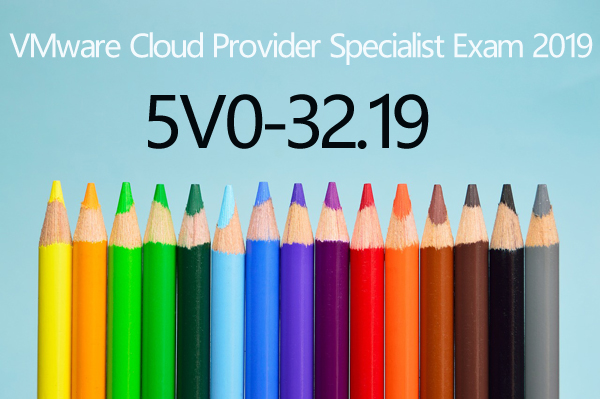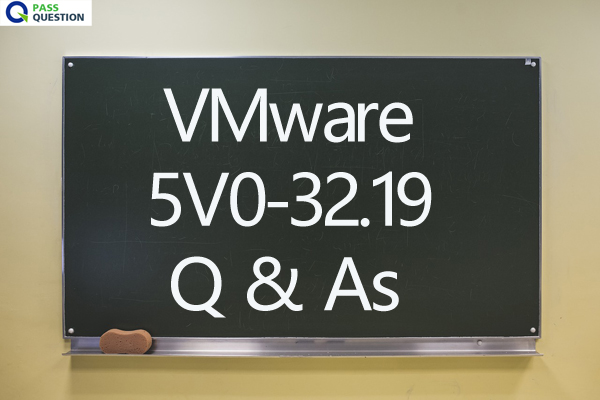VMware 5V0-32.19 Questions And Answers - VMware Cloud Provider Specialist Exam 2019
How to get 5V0-32.19 VMware Cloud Provider Specialist Exam 2019 success? For this, you should consider taking Passquestion VMware 5V0-32.19 Questions And Answers. Because these questions had been made by the hard work of the VMware experts, which will guarantee you 100% passing in VMware Specialist - Cloud Provider 2019 5V0-32.19 exam at the very first attempt.

5V0-32.19 Exam Information - VMware Cloud Provider Specialist Exam 2019
VMware Cloud Provider Specialist Exam (5V0-32.19) which leads to VMware Specialist – Cloud Provider 2019 badge is a 40-item exam, with a passing score of 300 using a scaled method. Candidates are given a time of 60 minutes. 5V0-32.19 exam tests expertise in deploying and managing VMware vCloud Director and demonstrates knowledge of the overall Cloud Provider Platform.

Badge Information
Achieving VMware Specialist – Cloud Provider 2019 Badge:
Path if you hold no certifications:
1. Achieve a current VCP-CMA, VCP-DCV, VCP-DTM, or VCP-NV
2. Pass the VMware Cloud Provider Specialist Exam (5V0-32.19)
Path if you hold a current VCP-CMA, VCP-DCV, VCP-DTM, or VCP-NV
1. Pass the VMware Cloud Provider Specialist Exam (5V0-32.19)
VMware Specialist - Cloud Provider 2019 5V0-32.19 Exam Sections
The exam sections and objectives outline the range of content that can be included in the exam.
Section 1 – VMware vCloud Director Architecture and Technologies
Section 2 – VMware Products and Solutions
Section 3 – NOT APPLICABLE TO THIS EXAM
Section 4 – Configure and install VMware vCloud Director
Section 5 and Section 6 – NOT APPLICABLE TO THIS EXAM
Section 7 – Administration and Operations of VMware vCloud Director

Share 5V0-32.19 Exam Questions And Answers:
1.What are the two primary use cases of VMware vCloud Availability for vCloud Director solution set? (Choose two.)
A. orchestrate VMware Fault Tolerance for a vApp in a vCloud Director environment
B. create an L2 VPN tunnel between on-premises vCenter and a vCloud Director environment
C. activate self-service Disaster Recovery between vCloud Director environments
D. automate creation of vCloud Director cells for high availability purposes
E. provide Disaster Recovery between on-premises vCenter to a vCloud Director environment
Answer: CE
2.A system administrator is adding new compute resources to an existing VMware vCloud Director installation.
Which two types of compute resources can be consumed by VMware vCloud Director version 9.1 for the capacity expansion? (Choose two.)
A. VMware vSphere ESXi host with vCloud networking and security
B. Red Hat KVM host with Open Switch
C. VMware vSphere Resource Pools in a new vCenter Server with NSX
D. VMware Integrated OpenStack host group
E. VMware vSphere cluster in an already added vCenter Server
Answer: CE
3.Which benefit does the VMware Cloud on AWS 1-node option in VMware Cloud Provider Hub provide?
A. no charge for running workloads for 30 days
B. smaller and cost-effective entry point, scale at 4+ nodes within 30 days
C. the ability to run VMware vCloud Director
D. the ability to run mission critical workloads for a tenant
Answer: B
4.Which VMware vCenter role is needed to access and configure properties pertaining to identity providers?
A. System Administrator
B. SSO Administrator
C. Administrator
D. Security Administrator
Answer: C
5.A cloud administrator creates a new organization virtual data center which meets these customer requirements:
- The customer wants to heavily over-commit CPU
- The customer requires mainly static workloads
- The customer requires to know how many resources are guaranteed to them
- The customer requires guaranteed resources at all times
Which allocation model meets these requirements?
A. elastic allocation pool
B. non-elastic allocation pool
C. pay-as-you-go
D. reservation pool
Answer: C
6.Which three Linux distributions are supported as the base operating system used for a VMware vCloud Director installation? (Choose three.)
A. CentOS
B. Oracle Linux
C. Amazon Linux
D. Red Hat Enterprise Linux
E. Debian
F. Ubuntu
Answer: ABD
7.Which VXLAN replication mode requires the deployment of NSX Controllers?
A. multicast
B. unicast
C. broadcast
D. anycast
Answer: B
- TOP 50 Exam Questions
-
Exam
All copyrights reserved 2025 PassQuestion NETWORK CO.,LIMITED. All Rights Reserved.

